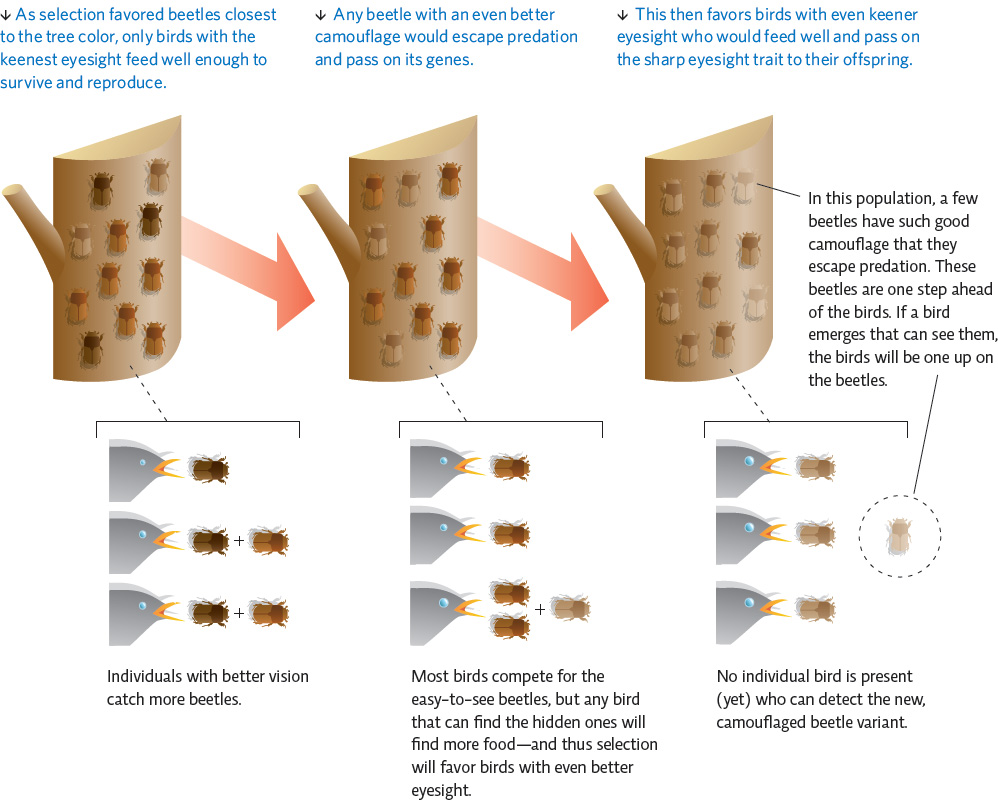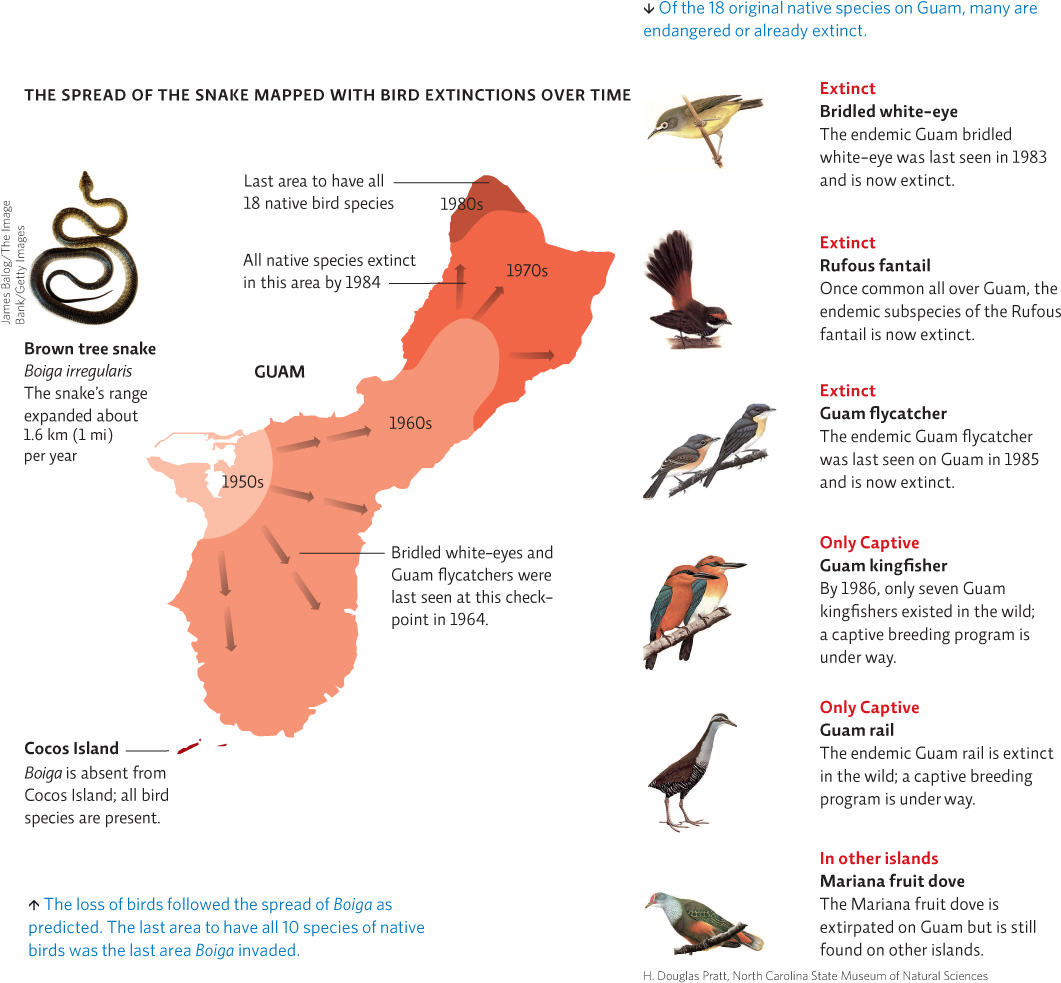Populations need genetic diversity to evolve.
KEY CONCEPT 11.2
Individuals do not evolve; populations do. A population is said to have evolved if the assortment and frequency of genes in a descendant population are different from those in its ancestral population.
The ability of a population to adapt is a reflection of its tolerance limits, which largely depend on genetic diversity—different individuals having different alleles. A population that is highly diverse (has individuals with many different traits) is likely to have wider tolerance limits (see Chapter 8), which increases the population’s potential to adapt to changes. This means it is more likely that some individuals will exist that can withstand (or even thrive in) the changes and that the population as a whole will survive. If a change occurs that produces a condition outside the range where individuals can survive and reproduce (for instance, the climate becomes too warm or too dry), the population will die out. Similarly, if a new challenge is presented, such as the introduction of a new predator or competitor, the survival of the population will depend on whether there are any individuals in the population who can effectively deal with the new species. If the snakes on Guam were indeed responsible for killing off the birds, any birds that happened to have effective snake-avoidance behaviors would have had a greater chance of survival.
genetic diversity
The heritable variation among individuals of a single population or within a species as a whole.
Two main sources of variation can increase genetic diversity in a population. The ultimate source of new variability is genetic mutation, a change in the DNA sequence in the sex cells that alters a gene, sometimes to the extent that it produces a new protein and, possibly, a new trait. Mutations are rare, but because DNA replication and repair occurs all the time, rare events do happen. When a mutation produces traits that are beneficial, they can quickly be passed on to the next generation, allowing the population to evolve to be better adapted to its environment. A second source of genetic variety occurs as eggs and sperm are made: Genetic recombination shuffles alleles around and sometimes produces individuals with new traits when a sperm fertilizes an egg.
203
204
KEY CONCEPT 11.3
Genetic diversity in a population is the raw material on which natural selection operates. The more diverse a population, the more likely there will be individuals present who can withstand or even thrive if environmental conditions change.
The value of this genetic diversity is illustrated today in the example of the rock pocket mouse of the American Southwest desert. Animals of this species have coats that are either light tan or a darker color. It turns out that coat color corresponds to a population’s environment: Areas of light-colored rock contain populations with mostly tan mice, whereas darker mice inhabit black lava rock regions. Research by Hopi Hoekstra and colleagues at the University of Arizona has shown that coat color is determined by a single gene that comes in two different alleles. The dominant allele is designated by the uppercase letter D; the recessive allele is designated by the lowercase letter d. All individuals have two copies of the gene, and the color of their coat is determined by which two alleles they possess. Darker mice have at least one dominant allele (DD or Dd). Tan mice possess two recessive alleles (dd).
It is likely that coat color provides camouflage and protection from visual hunters, but only if the mouse is on a background of the same color. A study on deer mice (a similar species) showed that predatory owls are more successful at capturing mice on a contrasting background. This gives support to the conclusion that coat color is adaptive as camouflage and therefore is responsive to natural selection. INFOGRAPHIC 11.2
EVOLUTION IN ACTION

©Rick & Nora Bowers/Alamy
Dr. Hopi Hoekstra
Sean Locke/Photodisc/Getty Images
Lyn Alweis/The Denver Post via Getty Images
Dr. Hopi Hoekstra
Dr. Hopi Hoekstra

If this mouse population migrated to an area with a red rock habitat with visual predators like hawks or owls, what could prevent the population from evolving into one with red coats?
The population could only evolve if the red trait was already present in some of the individuals. If the tan individuals showed some diversity with regard to redness in the coat color such that they were taken less often by predators, and this trait had a genetic basis, then natural selection may produce a predominately red population over time. But if this trait does not already exist or arise via mutation, natural selection would have nothing to select and all the mice would be vulnerable to predation.
205
KEY CONCEPT 11.4
When two species each become the selective pressure that favors certain traits in each other, coevolution is occurring. Coevolution can produce species that are highly adapted to one another.
A special type of natural selection is known as coevolution. In coevolution, two species each provide the selective pressure that determines which of the other’s traits is favored by natural selection. Predator and prey species usually evolve together, each exerting selective pressures that shape the other. As predators get better at catching prey, the only prey to survive are those a little better at escaping, and it is those individuals that reproduce and populate the next generation. This game of one-upmanship continues generation after generation, with each species affecting the differential survival and reproductive success of the other. The result can be a predator extremely well equipped to capture prey and prey extremely well equipped to escape. INFOGRAPHIC 11.3
coevolution
A special type of natural selection in which two species each provide the selective pressure that determines which traits are favored by natural selection in the other.
COEVOLUTION ALLOWS POPULATIONS TO ADAPT TO EACH OTHER


What do you predict would happen to the original beetle population if a species of bird with extremely keen eyesight (like those shown on the right side of the diagram) were accidently introduced into the beetle’s habitat?
The beetle population might be decimated before natural selection could favor those varieties who more closely matched their background. Coevolution would not have time to occur because the birds would come in with the far superior adaptation.
If the birds on Guam were indeed eradicated by the invasive snake species, it was because the speed at which the eradication happened prevented the bird populations from potentially coevolving survival strategies to deal with the new snake population. The brown tree snake was already well adapted to preying on birds. But Guam’s bird populations had never faced such a predator and had no natural defenses. It was an unfair fight. In fact, that the birds on Guam disappeared so quickly made it difficult to tease out the cause of their extinction at all. Savidge had to work backward to solve the mystery, putting the missing pieces together experiment by experiment. Her first step was to compare whether the distribution of the snakes on Guam matched up with the areas where birds had disappeared.
Based on what the residents told her, and what historical records like newspaper clippings reported, Savidge found that birds had begun to disappear first from southern Guam and that their disappearances matched up perfectly with when the brown tree snakes had begun populating the area. Ritidian, an area on the very northernmost tip of Guam, on the other hand, was the last area to have lost its birds, and it was also the last to be colonized by the snakes. “I found a close correlation between the bird decline and the expansion of brown tree snakes around the island,” she says, which suggested to her that brown tree snakes really might be the culprit. INFOGRAPHIC 11.4
ENDANGERED AND EXTINCT BIRDS OF GUAM

James Balog/The Image Bank/Getty Images
H. Douglas Pratt, North Carolina State Museum of Natural Sciences

Look at the progressive movement of the snake through Guam and the extinction of birds over the same time frame. Is this cause-and-effect evidence that the snake exterminated the birds, or is it correlational evidence? Explain.
It is correlational evidence - the two events occurred together with the extinctions closely following the movement of the snake into their area. To establish cause and effect, the snake would need to be introduced in a controlled environment (one that eliminated other causes of bird extinctions) and then the bird populations monitored for survival or extinction. However, taken with other correlational evidence (i.e. the snake eats birds, other snake prey declined over the same time frame, the persistence of populations in areas where the snake was excluded) it is reasonable to conclude that the snake was the main cause of extinction.
206
KEY CONCEPT 11.5
Because the brown tree snake coevolved with birds in its native habitat, it was very good at preying on birds. But the birds of Guam did not coevolve with a snake predator and therefore were not equipped to deal with a predatory snake.
Some of Guam’s bird species went extinct sooner than others. For instance, the endemic bridled white-eye, the gregarious bird species that was extinguished first, happens to be very small, raising the possibility that the small size of these birds might have put them at a disadvantage. Larger species like flycatchers survived longer, though they, too, eventually disappeared. Other bird species experienced extirpation; the Guam rail, for instance, is gone from Guam, but other populations still live on the nearby island of Rota.
endemic
Describes a species that is native to a particular area and is not naturally found elsewhere.
extirpation
Local extinction in one or more areas, though some individuals exist in other areas.